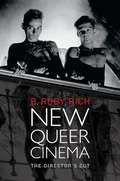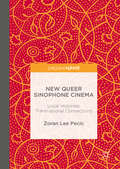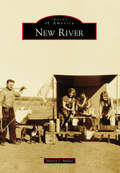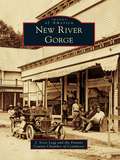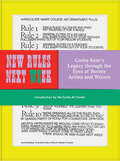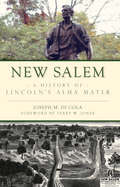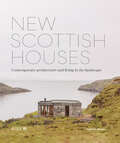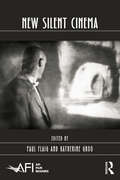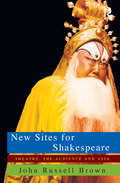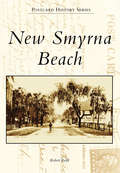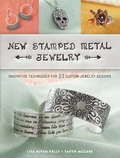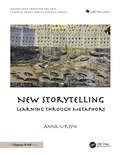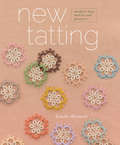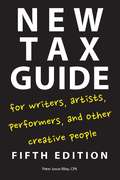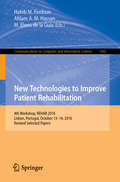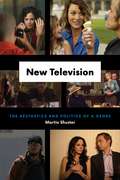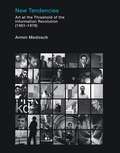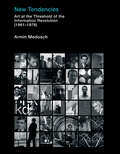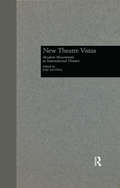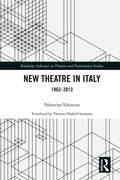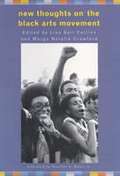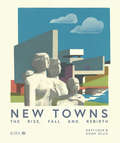- Table View
- List View
New Queer Cinema: The Director's Cut
by B. Ruby RichB. Ruby Rich designated a brand new genre, the New Queer Cinema (NQC), in her groundbreaking article in the Village Voice in 1992. This movement in film and video was intensely political and aesthetically innovative, made possible by the debut of the camcorder, and driven initially by outrage over the unchecked spread of AIDS. The genre has grown to include an entire generation of queer artists, filmmakers, and activists. As a critic, curator, journalist, and scholar, Rich has been inextricably linked to the New Queer Cinema from its inception. This volume presents her new thoughts on the topic, as well as bringing together the best of her writing on the NQC. She follows this cinematic movement from its origins in the mid-1980s all the way to the present in essays and articles directed at a range of audiences, from readers of academic journals to popular glossies and weekly newspapers. She presents her insights into such NQC pioneers as Derek Jarman and Isaac Julien and investigates such celebrated films as Go Fish, Brokeback Mountain, Itty Bitty Titty Committee, and Milk. In addition to exploring less-known films and international cinemas (including Latin American and French films and videos), she documents the more recent incarnations of the NQC on screen, on the web, and in art galleries.
New Queer Sinophone Cinema
by Zoran Lee PecicThis book looks closely at some of the most significant films within the field of queer Sinophone cinema. Examining queerness in films produced in the PRC, Taiwan and Hong Kong, the book merges the Sinophone with the queer, theorising both concepts as local and global, homebound as well as diasporic. Queerness in this book not only problematises the positioning of non-normative desires within the Sinophone; it also challenges Eurocentric critical perspectives on filmic representation that are tied to the idea of the binary between East/West. New Queer Sinophone Cinema will appeal to scholars in Chinese and film studies, as well as to anyone who is interested in queer Chinese cinema.
New River (Images of America)
by Marcy J. MillerLong before the cavalry and stagecoaches traveled through on military roads and the Old Black Canyon Stage Road, the ancient Hohokam people relied on New River's peaks for fortresses and lookouts. In the late 1800s, the military sweep of the last native people, the Apache and Yavapai, rendered the region safe for settlers. Situated between the cool north and the hot, arid Salt River Valley below, New River became a key location for watering sheep and cattle driven between seasonal pastures. Ranches, such as the Triangle-Bar, sprang to life in the cactus-studded foothills. From the 1920s to the 1940s, the arrival of tough, capable homesteaders formed the community that thrives today. Still an unincorporated area of north Maricopa County, New River retains its western heritage and scenic desert vistas
New River Gorge
by J. Scott Legg Fayette County Chamber of CommerceToday visitors to the New River Gorge see a steep gorge filled with a lush hardwood forest. Before the railroad, the New River, with its whitewater rapids, was a barrier to trade, but with the 1873 completion of the Chesapeake and Ohio Railroad, the gorge came alive. By the 1890s, more than 30,000 people lived and worked in the gorge. Towns like Kaymoor, Nuttallburg, and Thurmond were hives of activity and melting pots of American immigrants who dug the coal that helped build the American dream. Times changed. By 1960, the easiest coal was gone, and miners moved to Midwest factories. Nature began to reclaim the gorge. The 1970s brought a rebirth. Whitewater rafters took on the rapids, and bridge builders built the New River Gorge Bridge. The forest has returned, and if you look under the canopy, you will see that the railroads, coal camps, and mine tipples have given way to rafters, rock climbers, and mountain bikers.
New Rules Next Week: Corita Kent's Legacy through the Eyes of Twenty Artists and Writers
by Corita Art CenterTwenty contemporary artists and writers reimagine Corita Kent's iconic creative manifesto.Known for her vibrant and powerful serigraphs, Corita Kent left an equally important legacy through her teaching. In the late 1960s, she and her students at the Immaculate Heart College developed their Art Department Rules. From "Consider everything an experiment" to "Be happy whenever you can manage it," these ten deceptively simple principles capture the magic of Corita's approach to creativity, culture, and activism. In this volume, ten writers and ten artists look back at the rules and show us how vital and resonant they remain today. The wide-ranging roster of contributors includes Vashti Harrison, Lisa Congdon, Natacha Ramsay-Levi, Dan Paley, and Erin Jang.COMPELLING AND INSPIRING ARTIST: Corita Kent was a Roman Catholic nun, a wildly popular pop artist, a social justice advocate, and a beloved art teacher. Her Art Department Rules continue to speak to people today. This book celebrates the way Corita's work resonates through contemporary art and offers inspiration for your own creative practice.TWENTY AMAZING CONTRIBUTORS: Illustrators, designers, educators, curators, former students and colleagues of Corita's—the illustrious contributors to this volume offer a kaleidoscope of perspectives on the artist's legacy. PERFECT GIFT: This book makes an impactful gift for creative minds, especially students. The ten rules offer encouragement and guidance to anyone who aspires to begin or expand an artistic practice.Perfect for:Fans of Corita Kent's artwork, teaching, and activismArt school students, creative professionals, and artists of all kindsDevotees of the "Pop Art Nun," Andy Warhol, Ben Shahn, and activist artFans of art- and activism-focused coffee table books, art retrospectives, and creativity workbooks like The Artist's Way
New Salem: A History of Lincoln's Alma Mater (Brief History)
by Foreword By Jones Joseph M. ColaIn 1829, eleven years after Illinois became the twenty-first state, New Salem was founded on a bluff above the Sangamon River. The village provided an essential sanctuary for a friendless, penniless boy named Abraham Lincoln, whose six years there shaped his education and nurtured his ambition. Eclipsed by the neighboring settlement of Petersburg, New Salem had dwindled into a ghost town by 1840. However, it reemerged in the early part of the twentieth century as one of the most successful preservation efforts in American history. Author Joseph Di Cola relates the full story of New Salem’s fascinating heritage.
New Scottish Houses: Contemporary architecture and living in the landscape
by Isabelle PriestNew Scottish Houses: Contemporary Architecture and Living in the Landscape brings together for the first time the best examples of contemporary rural houses in Scotland. Showcasing the new rural vernacular that has developed in Scotland over the past 20 years, it presents this rich seam of architecturally designed houses as a new, exciting and specific movement that aims to be distinctly Scottish.Exploring the fusion of modern design with Scotland's rugged natural beauty, each case study explores a curate collection of contemporary homes that push the boundaries of design - from remote highlands to coastal hideaways. These homes have established a new vernacular for the region inspired by historical blackhouses, and place the buildings within an older 'pre-English' tradition of long houses: revising these lost traditions as more authentically Scottish, and more closely tied to Scotland's landscape, geology and climate.Featuring striking photographs and insightful commentary, this beautiful book celebrates how architects and homeowners are creating spaces that are both sustainable and inspirational, reflecting the evolving identity of Scotland's built environment in the 21st century.Architects featured include: Mary Arnold Forster Paper Igloo Dualchas Brown and Brown Architects Denizen Works
New Silent Cinema: Digital Anachronisms, Celluloid Spectacles (AFI Film Readers)
by Katherine Groo Paul FlaigWith the success of Martin Scorsese’s Hugo (2011) and Michel Hazanavicius’s The Artist (2011) nothing seems more contemporary in recent film than the styles, forms, and histories of early and silent cinemas. This collection considers the latest return to silent film alongside the larger historical field of visual repetitions and affective currents that wind their way through 20th and 21st century visual cultures. Contributors bring together several fields of research, including early and silent cinema studies, experimental and new media, historiography and archive theory, and studies of media ontology and epistemology. Chapters link the methods, concerns, and concepts of early and silent film studies as they have flourished over the last quarter century to the most recent developments in digital culture—from YouTube to 3D—recasting this contemporary phenomenon in popular culture and new media against key debates and concepts in silent film scholarship. An interview with acclaimed Canadian filmmaker Guy Maddin closes out the collection.
New Sites For Shakespeare: Theatre, the Audience, and Asia
by John Russell BrownIn the course of exploring the theatrical cultures of South and East Asia, eminent Shakespeareanist John Russell Brown developed some remarkable theories about the nature of performance, the state of Western 'Theatre' today, and the future potential of Shakespeare's plays. In New Sites for Shakespeare he outlines his passionate belief in the power of theatre to reach mass audiences, based on his experiences of popular Asian performances. It is a personal polemic, but it is also a carefully argued and brilliantly persuasive study of the kind of theatrical experience Shakespeare's own contemporaries enjoyed. This is a book which cannot be ignored by anyone who cares about the live performing arts today. Separate chapters consider staging, acting, improvisation, ceremonies and ritual, and an analysis of the experience of the audience is paramount throughout.
New Smyrna Beach (Postcard History Series)
by Robert ReddIn 1768, Scottish physician Andrew Turnbull arrived in Florida with more than 1,200 indentured servants. He and his partners dreamed of establishing a plantation settlement that would make them wealthy. Despite some successes, New Smyrna was not the financial windfall they had hoped for, and after only nine years, the settlement failed. Disgruntled workers appealed to East Florida governor Patrick Tonyn, who granted them their freedom. Many of the now free settlers took residence in St. Augustine. In the succeeding years, New Smyrna has seen Civil War skirmishes, the addition of �Beach� to its name, a merger with Coronado Beach, the rise and fall of the rail industry, and a marked increase in local and out-of-state tourism. The �World�s Safest Bathing Beach� is no longer a local secret.
New Stamped Metal Jewelry: Innovative Techniques for 23 Custom Jewelry Designs
by Lisa Niven Kelly Taryn MccabeInnovative Techniques for 23 Custom Jewelry Designs
New Storytelling: Learning through Metaphors
by Anna UrsynThere is a global need to become less fearful of coding, as it improves communication with the coders on the job and helps with prompt writing, which hiring companies often request. This set of story-based learning projects links performances and tasks with computing codes to show how a machine translates our goals into its language. Metaphors link instructions telling a computer what task to perform with similar functions in other disciplines. The materials serve those in Computer Graphics, Digital Media, or anyone interested in understanding and becoming familiar with principles and the logic behind coding, and help understand machines when writing a prompt. Dance, music, and performing visually present knowledge through stories and serve as a metaphor for understanding how coding and current technologies affect various disciplines. By introducing basic ideas behind programming in a symbolic way, this book shows how computing and nature overlap through storytelling.Most jobs are collaborative, and coding involves many parts of production processes. These knowledge-based stories improve communication between the artists and the coders to bridge the gap between them.It is a part of the “Knowledge Through the Arts” series, consisting of:Dance Code - Dance Steps as a CodeNew Storytelling - Learning Through MetaphorsCode Appreciation - Reshaping KnowledgeNature Appreciation - Knowledge as Art
New SubUrbanisms
by Judith K De JongHistorically, we see the city as the cramped, crumbling core of development and culture, and the suburb as the vast outlying wasteland – convenient, but vacant. Contemporary urban design proves this wrong. In New SubUrbanisms, Judith De Jong explains the on-going "flattening" of the American Metropolis, as suburbs are becoming more like their central cities – and cities more like their suburbs through significant changes in spatial and formal practice as well as demographic and cultural changes. These revisionist practices are exemplified in the emergence of hybrid sub/urban conditions such as parking practices, the residential densification of suburbia, hyper-programmed public spaces and inner city big-box retail, among others. Each of these hybridized conditions reflects to varying degrees the reciprocating influences of the urban and the suburban. Each also offers opportunities for innovation in new formal and spatial practices that re-configure conventional understandings of urban and suburban, and in new ways of forming the evolving American metropolis. Based on this new understanding, De Jong argues for the development of new ways of building the city. Aimed at students and practitioners of urban design and planning New SubUrbanisms attempts to re-frame the contemporary metropolis in a way that will generate more instrumental engagement – and ultimately, better design.
New Suburbanism: Tall Buildings And Sustainable Development (Design and the Built Environment)
by Kheir Al-KodmanyMuch of the anticipated future growth in the United States will take place in suburbia. The critical challenge is how to accommodate this growth in a sustainable and resilient manner. This book explores the role of suburban tall as a viable, sustainable alternative to continued suburban sprawl. It identifies 10 spatial patterns in which tall buildings have been integrated into the American suburbs. The study concludes that the Tall Building and Transit-Oriented-Development (TB-TOD) model is the most appropriate to promote sustainable suburbanism. The findings are based on analyzing over 300 projects in 24 suburban communities within three major metropolitan areas including: Washington, DC, Miami, Florida, and Chicago, Illinois. The book furnishes planning strategies that address the social, economic, and environmental aspects of sustainable tall building development. It also discusses sustainable architectural design and site planning strategies and provides case studies of sustainable tall buildings that were successfully integrated into suburban settings.
New Tatting: Modern Lace Motifs and Projects
by Tomoko MorimotoA beautiful and detailed introduction to tatting! With the growing interest in lace, New Tatting is a fantastic book for getting started in the craft. Tatting is a means of creating lace by looping threads together using tiny shuttles and your fingers (with occasional help from a crochet hook). It creates dainty chains and edgings as well as single motifs and is used to edge and decorate textiles and clothing, as jewelry, or as large-scale lace projects in itself. Tatting is getting new respect in the crafting world as people discover its traditional beauty while giving it a more modern inflection. In New Tatting, you will explore modern color and a fresh approach to tatting with incredible step by-step photos and beautiful projects. This book appeals to people who have never tatted before as well as tatters looking for something new and inspirational. Anyone interested in making lace will find that New Tatting offers everything needed to get started.
New Tax Guide for Writers, Artists, Performers, and Other Creative People
by Peter Jason RileyNew Tax Guide provides an in-depth look at income and taxes for various types of artists, writers, performers, and other creative people. A general guide to smart record keeping, business and tax forms, best practices, and common mistakes to avoid, the fifth edition offers creatively employed individuals the most current and clear advice on topics such as crowdfunding, deductible expenses, and what to do if you get audited.
New Technologies in Building and Construction: Towards Sustainable Development (Lecture Notes in Civil Engineering #258)
by David Bienvenido-Huertas Juan Moyano-CamposThis book presents contributions on new technologies in building and construction. Buildings are complex elements that impact environment significantly. The sustainability of this sector requires a holistic and multidisciplinary approach that allows adequate strategies to be established to reduce its environmental impact. This heterogeneity is represented in these chapters, which have been developed by researchers from different countries. The book is divided into three sections: (i) analysis, (ii) design and modeling, and (iii) solutions. The book chapters together represent an advance in current knowledge about new technologies in building and construction, crucial for researchers, engineers, architects, policy makers, and stakeholders.
New Technologies to Improve Patient Rehabilitation: 4th Workshop, REHAB 2016, Lisbon, Portugal, October 13-14, 2016, Revised Selected Papers (Communications in Computer and Information Science #1002)
by Habib M. Fardoun Ahlam A. Hassan M. Elena de la GuíaThis book constitutes the thoroughly refereed proceedings of the 4th International Workshop on ICTs for Improving Patients Rehabilitation Research Techniques, REHAB 2016, held in Lisbon, Portugal, in October 2016.The 10 revised full papers presented were carefully reviewed and selected from 33 submissions. The papers explore how technology can contribute toward smarter and effective rehabilitation methods.
New Television: The Aesthetics and Politics of a Genre
by Martin ShusterEven though it’s frequently asserted that we are living in a golden age of scripted television, television as a medium is still not taken seriously as an artistic art form, nor has the stigma of television as “chewing gum for the mind” really disappeared. Philosopher Martin Shuster argues that television is the modern art form, full of promise and urgency, and in New Television, he offers a strong philosophical justification for its importance. Through careful analysis of shows including The Wire, Justified, and Weeds, among others; and European and Anglophone philosophers, such as Stanley Cavell, Hannah Arendt, Martin Heidegger, and John Rawls; Shuster reveals how various contemporary television series engage deeply with aesthetic and philosophical issues in modernism and modernity. What unifies the aesthetic and philosophical ambitions of new television is a commitment to portraying and exploring the family as the last site of political possibility in a world otherwise bereft of any other sources of traditional authority; consequently, at the heart of new television are profound political stakes.
New Tendencies: Art at the Threshold of the Information Revolution (1961 - #1978)
by Armin MedoschNew Tendencies, a nonaligned modernist art movement, emerged in the early 1960s in the former Yugoslavia, a nonaligned country. It represented a new sensibility, rejecting both Abstract Expressionism and socialist realism in an attempt to formulate an art adequate to the age of advanced mass production. In this book, Armin Medosch examines the development of New Tendencies as a major international art movement in the context of social, political, and technological history. Doing so, he traces concurrent paradigm shifts: the change from Fordism (the political economy of mass production and consumption) to the information society, and the change from postwar modernism to dematerialized postmodern art practices. Medosch explains that New Tendencies, rather than opposing the forces of technology as most artists and intellectuals of the time did, imagined the rapid advance of technology to be a springboard into a future beyond alienation and oppression. Works by New Tendencies cast the viewer as coproducer, abolishing the idea of artist as creative genius and replacing it with the notion of the visual researcher. In 1968 and 1969, the group actively turned to the computer as a medium of visual research, anticipating new media and digital art.Medosch discusses modernization in then-Yugoslavia and other nations on the periphery; looks in detail at New Tendencies' five major exhibitions in Zagreb (the capital of Croatia); and considers such topics as the group's relation to science, the changing relationship of manual and intellectual labor, New Tendencies in the international art market, their engagement with computer art, and the group's eventual eclipse by other "new art practices" including conceptualism, land art, and arte povera. Numerous illustrations document New Tendencies' works and exhibitions.
New Tendencies: Art at the Threshold of the Information Revolution (1961 - 1978) (Leonardo)
by Armin MedoschAn account of a major international art movement originating in the former Yugoslavia in the 1960s, which anticipated key aspects of information aesthetics.New Tendencies, a nonaligned modernist art movement, emerged in the early 1960s in the former Yugoslavia, a nonaligned country. It represented a new sensibility, rejecting both Abstract Expressionism and socialist realism in an attempt to formulate an art adequate to the age of advanced mass production. In this book, Armin Medosch examines the development of New Tendencies as a major international art movement in the context of social, political, and technological history. Doing so, he traces concurrent paradigm shifts: the change from Fordism (the political economy of mass production and consumption) to the information society, and the change from postwar modernism to dematerialized postmodern art practices. Medosch explains that New Tendencies, rather than opposing the forces of technology as most artists and intellectuals of the time did, imagined the rapid advance of technology to be a springboard into a future beyond alienation and oppression. Works by New Tendencies cast the viewer as coproducer, abolishing the idea of artist as creative genius and replacing it with the notion of the visual researcher. In 1968 and 1969, the group actively turned to the computer as a medium of visual research, anticipating new media and digital art.Medosch discusses modernization in then-Yugoslavia and other nations on the periphery; looks in detail at New Tendencies' five major exhibitions in Zagreb (the capital of Croatia); and considers such topics as the group's relation to science, the changing relationship of manual and intellectual labor, New Tendencies in the international art market, their engagement with computer art, and the group's eventual eclipse by other “new art practices” including conceptualism, land art, and arte povera. Numerous illustrations document New Tendencies' works and exhibitions.
New Theatre Vistas: Modern Movements in International Literature (Studies in Modern Drama)
by Judy L. OlivaFirst Published in 1996. Part of a series of ‘Studies in Modern Drama’, Volume 7 This volume Studies in Modern Drama collects essays on contemporary theatre which reveal the changing face of the world, as well as challenges to the boundaries of traditional stage production. Authors examine familiar texts in new settings, discovering what editor Judy Lee Oliva calls “the effect of cultural- specific gestures, stances and the nuance of words,” so that audiences and critics are forced to recognize stereotypes and re-evaluate older critical methods. Topics range from directing gay and working-class theatre in Scotland to producing American and British drama in Holland, Belgium, and Poland. New voices in the theatre are heard, and old ones are put to new tests. What remains is the power of performance to inspire emotional and intellectual response. Writers, directors, costume designers, producers, and critics provide an uncommon range of perspectives to the changing roles of theatre in an increasingly global community.
New Theatre in Italy: 1963–2013 (Routledge Advances in Theatre & Performance Studies)
by Valentina ValentiniNew Theatre in Italy 1963-2013 makes the case for the centrality of late-millennium Italian avant-garde theatre in the development of the new forms of performance that have emerged in the 21st Century. Starting in the Sixties, young artists and militants in Italy reacted to the violence in their streets and ruptures in the family unit that are now recognized as having been harbingers of the end of the global post-war system. As traditional rituals of State and Church faltered, a new generation of cultural operators, largely untrained and driven away from political activism, formed collectives to explore new ways of speaking theatrically, new ways to create and experience performance, and new relationships between performer and spectator. Although the vast majority of the works created were transient, like all performance, their aesthetic and social effects continue to surface today across media on a global scale, affecting visual art, cinema, television and the behavioural aesthetics of social networks.
New Thoughts On The Black Arts Movement
by Emily Bernard James Smethurst Lee Bernstein Alondra Nelson Margo Natalie Crawford Kellie Jones Erina Duganne Lisa Gail Collins Cherise Pollard Cherise Smith Wendy Walters Michelle Joan Wilkinson Lorrie Smith Houston Baker Adam Gussow Rod Hernandez Mary Ellen LennonDuring the 1960s and 1970s, a cadre of poets, playwrights, visual artists, musicians, and other visionaries came together to create a renaissance in African American literature and art. This charged chapter in the history of African American culture—which came to be known as the Black Arts Movement—has remained largely neglected by subsequent generations of critics. New Thoughts on the Black Arts Movement includes essays that reexamine well-known figures such as Amiri Baraka, Larry Neal, Gwendolyn Brooks, Sonia Sanchez, Betye Saar, Jeff Donaldson, and Haki Madhubuti. In addition, the anthology expands the scope of the movement by offering essays that explore the racial and sexual politics of the era, links with other period cultural movements, the arts in prison, the role of Black colleges and universities, gender politics and the rise of feminism, color fetishism, photography, music, and more. An invigorating look at a movement that has long begged for reexamination, this collection lucidly interprets the complex debates that surround this tumultuous era and demonstrates that the celebration of this movement need not be separated from its critique.
New Towns: The Rise, Fall and Rebirth
by Hugh Ellis Katy LockOften misunderstood, the New Towns story is a fascinating one of anarchists, artists, visionaries, and the promise of a new beginning for millions of people. New Towns: The Rise Fall and Rebirth offers a new perspective on the New Towns Record and uses case-studies to address the myths and realities of the programme. It provides valuable lessons for the growth and renewal of the existing New Towns and post-war housing estates and town centres, including recommendations for practitioners, politicians and communities interested in the renewal of existing New Towns and the creation of new communities for the 21st century.
